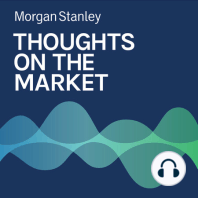3 min listen

U.S. Consumer: What’s Coming for Spending in 2023?
U.S. Consumer: What’s Coming for Spending in 2023?
ratings:
Length:
8 minutes
Released:
Feb 14, 2023
Format:
Podcast episode
Description
Though U.S. consumer spending was surprisingly robust in 2022, this poses both new and continuing challenges as households draw down their excess savings.----- Transcript -----Michelle Weaver: Welcome to Thoughts on the Market. I'm Michelle Weaver from the Morgan Stanley U.S. Equity Strategy Team. Sarah Wolfe: And I'm Sarah Wolfe from the U.S. Economics Team. Michelle Weaver: On this special episode of the podcast, we'll discuss how the U.S. consumer is faring. It's Tuesday, February 14th at 10 a.m. in New York. Michelle Weaver: The health of the consumer is critical for the equity market, and consumer spending last year helped companies continue to grow their earnings. Sarah, can you give us a snapshot of the overall health of the U.S. consumer right now? Do people still have plenty of savings, and what are you expecting around consumer savings for the rest of the year? Sarah Wolfe: The U.S. consumer was extraordinarily strong in 2022, despite negative real disposable income growth. For perspective, spending was about 3% growth year over year in 2022, and real disposable income was negative 6.5%. Part of that was inflation eroding all income gains, but it was also a tough year as we lapped fiscal stimulus from 2021. So what got consumers through negative 6.5% real income growth? It was this excess savings story. Consumers tapped their excess savings pretty significantly, and we estimate that the drawdown was roughly 30% from its peak. However, when we look into 2023, we don't think consumers are going to be tapping into their savings reserves quite as much. Michelle Weaver: It sounds like households draw down quite a bit of their excess saving. Is there any danger that they're going to run out? And if that's the case, when do you think that will play out? Sarah Wolfe: So we don't think 100% of excess savings are going to get spent ever. Remember, savings is not cash in your wallet, it's just anything that hasn't been spent. So some of these savings have moved into longer term investment vehicles as well. We think that an additional 15% will get spent in 2023, and 10% in 2024, after 30% drawdown last year. This slower drawdown in the excess savings will allow the savings rate to recover after sitting at a two decade low in 2022 at roughly 3%. But there are important divergences when you look at the distributional holding of excess savings. For example, the bottom 25% has drawn down over 50% of their excess savings, compared to 30% overall. And we believe they're on track to run their savings dry by 2Q 2023. Michelle Weaver: Great. And then income, of course, is another really important source of spending for consumers. And the January jobs report we got was a big surprise. And the labor market continues to be pretty resilient without any clear signs of stopping. I run a proprietary survey in conjunction with our Alphawise team, and in our most recent wave we found that despite the tech layoffs that have been all over the news, 31% of people are actually less worried about losing their job now versus a year ago. Can you tell me a little bit about what your team expects for the labor market in 2023? Sarah Wolfe: Well, the February jobs report was a whopper by any standard, 517,000 jobs and the unemployment rate hitting all time lows at 3.4%. However, I think it's important to put these numbers into a bit of context. We identified three temporary factors that boosted nonfarm payrolls in January and that we think are unlikely to persist in February. The first is weather. A warmer than usual January added about 130,000 jobs last month. The return of strike workers added 36,000 jobs and seasonal factors added 3 million jobs. Typically, we see the shedding of a lot of workers in January after the holidays, so leisure and hospitality, retail workers, transportation. But because we're dealing with significant labor shortages, and as a result companies are hoarding workers, we're seeing a lot fewer layoffs than we typically would given
Released:
Feb 14, 2023
Format:
Podcast episode
Titles in the series (100)
Mike Wilson: Are U.S. Economic Indicators Flashing Yellow? by Thoughts on the Market